IDEX Online Research: Polished Diamond Prices Slip in July
August 02, 12
(IDEX Online) – Global polished diamond prices are down from both June levels as well as from the same month a year ago. In July, prices declined 2.4 percent as compared to June and 6.9 percent year-over-year.
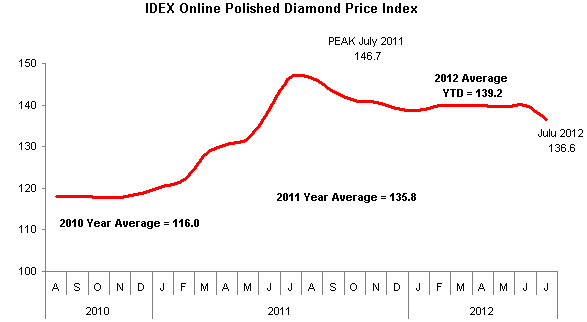 Source: IDEX Online Research |
The price trends are uneven. Prices for round diamonds have suffered, while prices for fancy cut stones are mostly higher. Further, some market-related issues are also putting pressure on polished diamond prices.
The IDEX Online Global Polished Diamond Price index, widely recognized as the most transparent and accurate indicator of polished diamond prices, showed the following trends during July 2012:
· Polished diamond prices fell by 2.4 percent in July, when compared to June price levels. The graph below illustrates monthly price trends.
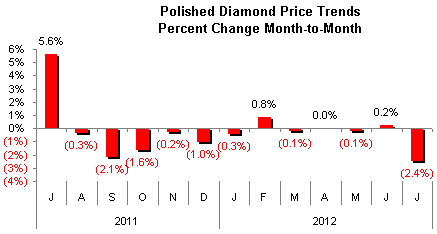 Source: IDEX Online Research |
· Polished diamond prices fell by 6.9 percent in July, when compared to July 2011 price levels. This is the first year-to-year decline in more than two years, and it is a worrisome trend.
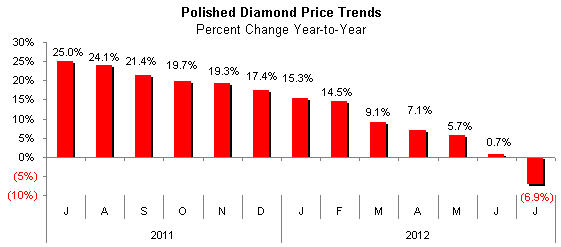 Source: IDEX Online Research |
· Daily price action softened throughout the month of July, though there was a brief spike in prices just after mid-month. It appears that diamantaires were “testing the market,” and when their attempt at raising prices was repelled by retailers, the market settled back into its downward slope.
· Polished diamond prices have fallen 1.6 percent in the seven-month period since the beginning of the year.
· Polished diamond prices for the first seven months of 2012 versus the first seven months of 2011 are up a modest 2.5 percent. This is the only good news related to overall diamond prices.
Underlying Price Trends Are Unmistakable
When the trends affecting diamond prices are examined in detail, they clearly explain what is happening.
· There have been two diamond price bubbles in the past six years: one in mid-2008 and one in mid-2011. In both cases, rough diamond prices followed closely, and when polished prices started to decline, manufacturers were squeezed by the opposing trends, harming profits.
The graph below summarizes polished diamond price trends over the past six years.
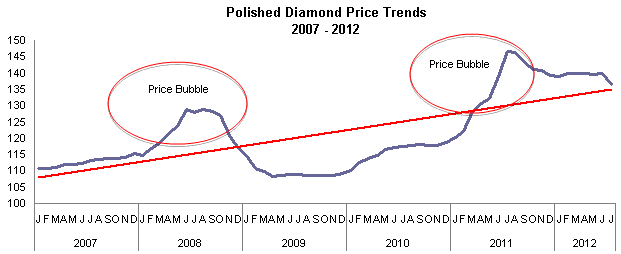 Source: IDEX Online Research |
The long view (red line on graph above) shows positive and reasonable trends. First, polished diamond prices have risen over the past six years at a rate of about four percent annually. While this is at the top end of the range of historic annual price increases, it is both a reasonable and manageable level.
Second, no market – stock markets, housing markets, commodities markets – moves evenly. All markets wax and wane, ebb and flow, including both the rough and polished diamond markets. Smart diamantaires take advantage of these market moves to make a profit and grow their business.
· Round diamond prices are down, while fancy diamond prices are up. Those diamantaires who are in touch with the American market already know why this trend is occurring:
The table below illustrates the polished diamond price trends by diamond cut. With the exception of five-carat polished round diamonds, prices of every other key round diamond have fallen this year. In dramatic contrast, the key fancy cut diamonds have all shown an increase in price during 2012, as the table below illustrates:
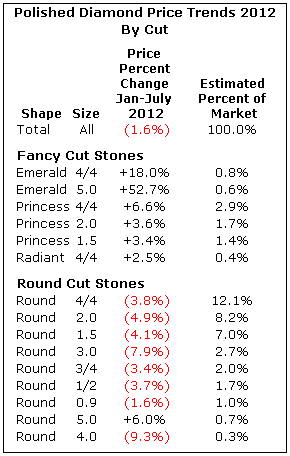 Source: IDEX Online Research |
· Retailers in both
· Financing for polished diamond suppliers has been tight, especially in
· Demand for polished diamonds in the
Diamond Prices by Size: Down for Every Major Size
Prices of round diamond declined for every major size in July, when compared to prices in June.
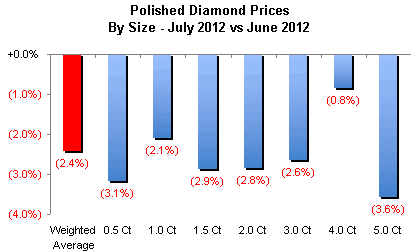 Source: IDEX Online Research |
On a year-over-year comparison, prices of round diamond were down for all key diamond sizes, when compared to July 2011.
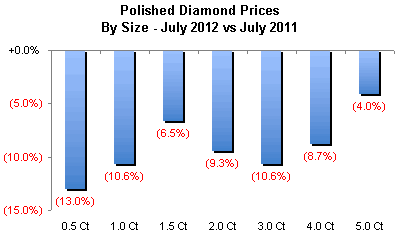 Source: IDEX Online Research |
Long Term Trend Shows Diamond Prices Weakening Since Mid-2011 Bubble
After rising slowly since mid-2010, most polished diamond prices – by carat size – have been relatively stable, though with a weakening bias, with the exception of February, when it appeared that polished diamond prices were headed higher. July polished diamond prices slipped for almost all major round stones, though they were up for fancies. The graph below illustrates price trends by diamond size.
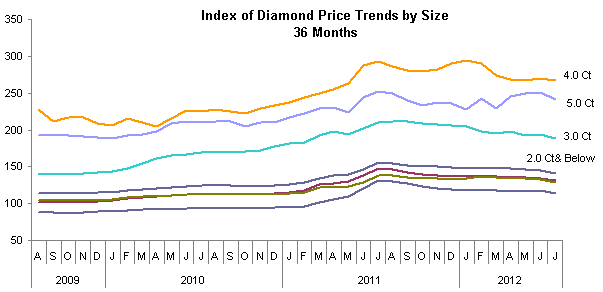 Source: IDEX Online Research |
Outlook Unchanged – Lackluster Price Trends
There are no significant large global markets where diamond and jewelry demand is exceptionally strong, nor has demand totally collapsed in any markets recently. Overall, it appears that the current positive factors affecting diamond prices in 2012 are being cancelled by the negative factors, with a weakening bias.
· The OECD Composite Leading Economic Indicators for the Euro Area continue to point to below-trend economic growth.
§
§
§
§
§
Longer term, polished diamond prices appear to be headed higher due to several factors within the diamond market:
· Emerging markets, including
· Rough diamond supplies appear to be flat, at best, for the next decade or longer. With flattish supply, but rising demand, the forces of capitalism will push diamond prices higher.
Until global economic conditions solidify and accelerate, it is unlikely that polished diamond prices will begin to move substantially higher near term. We note that price trends for most other commodities used in jewelry – precious metals and colored gemstones – have been relatively flat since the beginning of the year, with no energy to move higher until economic conditions improve.
The table below summarizes the average price of polished diamonds, using the IDEX Online Polished Diamond Price Index. The pre-recession peak for diamond prices occurred in August 2008 (box). As expected, polished diamond prices were weak during the “Great Recession” which officially ended in mid-2009. Unfortunately, polished diamond prices lagged the general economic recovery, and did not begin to show an upward bias until early 2010. The new, latest record price level (red box) occurred in July 2011. After slipping, prices remained relatively stable since October 2011, until this month.
 Source: IDEX Online Research |